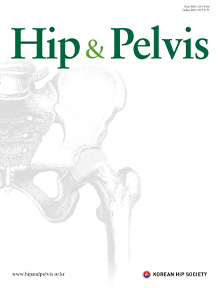Related article in
-
Case ReportSeptember 1, 2013
 0
0
 48
48
 13
13
Liner Dissociation by Extrusion of the Acetabular Cup Fixation Screw after Total Hip Replacement : Two Cases Report
Yoo-Sun Jeon, MD*, Deuk-Soo Hwang, MD, Chan Kang, MD, Pil-Sung Kim, MD†, Jung-Mo Hwang, MD, Jae-Hwang Song, MD
Hip Pelvis 2013; 25(3): 220-225AbstractThis is a report of 2 cases that showed dissociation of the acetabular cup liner by acetabular fixation screw among patients who underwent total hip replacement. Screws for fixation of the acetabular cup were used during the primary surgery in both cases. Each patient visited the out patient department complaining of pain and noise from the joint; radiologic finding revealed a collapse of the column shape bone graft area with dissociation of the acetabular cup liner. In both cases, during revision surgery, screw was extruded to the inner side of the acetabular cup, since it migrated superiorly. There has been no report of liner dissociation by extrusion of acetabular cup fixation screw after total hip replacement. Therefore, we report two cases of dissociation of the acetabular cup liner of hip arthroplasty, which occurred due to screw issues after total hip replacement with structural autogenous bone graft. -
Case ReportDecember 31, 2017
 0
0
 78
78
 18
18

Acetabular Insufficiency Fracture Following Prolonged Alendronate Use and the Failure of Total Hip Arthroplasty in “Frozen” Bone: Two Cases Report
Sang-Joon Kwak, MD*,†, Yoon-Je Cho, MD*, Gwang-Young Jung, MD*, Joo-Hyun Lee, MD*, Young-Soo Chun, MD‡, Kee-Hyung Rhyu, MD‡
Hip Pelvis 2017; 29(4): 286-290AbstractAtypical insufficiency fracture of the femur following prolonged bisphosphonate use is well described. Regardless of the cause, insufficiency fracture of the acetabulum is extremely rare, and no reports have described insufficiency fractures of the acetabulum that are associated with prolonged bisphosphonate use. This report demonstrates the possibility of insufficiency fracture at the acetabulum following long-term alendronate use and the necessity of particular care in managing insufficiency fractures in “frozen” bone. We describe two cases of insufficiency fracture of the acetabulum following 6 years of alendronate use. Given the patients’ medical histories and bone biopsy findings, these insufficiency fractures were thought to be attributable to alendronate use. One case involved the left hip and the presence of pelvic fractures on the opposite side. The patient was treated using cementless total hip arthroplasty (THA), which failed 1 year after surgery. The hip was revised with a massive bone graft and a supportive wire mesh. The other case was managed via THA with a Ganz reinforcement ring due to concerns regarding the use of a cementless implant. -
Original ArticleSeptember 30, 2019
 0
0
 59
59
 20
20

Prognostic Factors and Clinical Outcomes after Treatment of Periprosthetic Femoral Fractures Using a Cable-plate
Joon Soon Kang, MD, PhD, Kyoung-Ho Moon, MD, PhD, Bong Sung Ko, MD, Tae Hoon Roh, MD*, Yeop Na, MD, Yung-Hun Youn, MD, Joo Hyun Park, MD
Hip Pelvis 2019; 31(3): 166-173 AbstractPurpose: To analyze prognostic factors for the treatment of periprosthetic femoral fractures (PFFs) using the cable-plate construct.
AbstractPurpose: To analyze prognostic factors for the treatment of periprosthetic femoral fractures (PFFs) using the cable-plate construct.
Materials and Methods: A retrospective review of a consecutive series of 41 PFFs treated by osteosynthesis using the cable-plate system. The mean age of patients was 67.3±12.1 years (range, 42-86 years) and the mean follow-up period was 31.5±11.6 months (range, 12-58 months). Fresh frozen cortical strut allografts were leveraged in three cases for additional stability. Prognostic factors that may potentially affect clinical outcomes were analyzed.
Results: At the time of final follow-up, fracture union was obtained in 29 hips (70.7%; Group I) after an average of 13.5 weeks (range, 12-24 weeks). Healing failure after surgical treatment was observed in 12 cases (29.3%; Group II), including delayed union (n=10) cases and nonunion (n=2). Factors significantly associated with fracture union included fracture pattern (P=0.040), plate overlap percentage to stem length (P<0.001) and T-score at the preoperative bone mineral density (P=0.011). Transverse-type fractures around or just distal to a well-fixed femoral stem were observed in six cases (50.0%) of Group II.
Conclusion: The cable-plate osteosynthesis of PFFs should be performed with caution in transverse-type fractures or in cases with severe osteoporosis. Fixation with sufficient plate overlap to stem length may be critical to prevent healing failure. -
Original ArticleSeptember 30, 2021
 0
0
 95
95
 29
29

How Does Iron Deficiency Anemia Impact Outcomes following Revision Total Hip Arthroplasty?
Mohamed M. Sylla, BS*,†
Hip Pelvis 2021; 33(3): 140-146 , Lauren Gruffi, BS*,†, Eric S. Roth, MD†, Francis E. Rosato, MD†, Che Hang Jason Wong, MD†, Afshin E. Razi, MD†AbstractPurpose: Studies have shown the prevalence of iron deficiency anemia (IDA) increasing worldwide, and currently the literature is limited on the impact of IDA on outcomes following revision total hip arthroplasty (RTHA). Therefore, the purpose of this study was to determine whether IDA patients undergoing RTHA have longer: 1) in-hospital lengths of stay (LOS); 2) medical complications; and 3) costs of care.
, Lauren Gruffi, BS*,†, Eric S. Roth, MD†, Francis E. Rosato, MD†, Che Hang Jason Wong, MD†, Afshin E. Razi, MD†AbstractPurpose: Studies have shown the prevalence of iron deficiency anemia (IDA) increasing worldwide, and currently the literature is limited on the impact of IDA on outcomes following revision total hip arthroplasty (RTHA). Therefore, the purpose of this study was to determine whether IDA patients undergoing RTHA have longer: 1) in-hospital lengths of stay (LOS); 2) medical complications; and 3) costs of care.
Materials and Methods: A retrospective query of a nationwide administrative claims database was performed. Using Boolean command operations, the study group consisted of all patients in the database undergoing RTHA with IDA; whereas, patients without IDA served as controls. To reduce the effects of confounding, study group patients were matched to controls in a 1:5 ratio by age, sex, and medical comorbidities yielding 92,948 patients with (n=15,508) and without (n=77,440) IDA undergoing revision THA. A P-value less than 0.001 was considered statistically significant.
Results: IDA patients were found to have significantly longer in-hospital LOS (5 days vs. 4 days, P<0.0001). Additionally, the study showed IDA patients were found to higher incidence and odds of (73.84% vs. 11.77%, OR 5.04, P<0.0001) 90-day medical complications. IDA patients also incurred high 90-day episode of care costs ($25,597.51 vs. $20,085.70, P<0.0001).
Conclusion: After adjusting for age, sex, and medical comorbidities this study of over 92,000 patients demonstrated IDA is associated with longer in-hospital LOS, complications, and costs of care. Future studies should compare the duration and severity of IDA on outcomes. -
Original ArticleMarch 1, 2008
 0
0
 64
64
 12
12
Minimum 3 years Follow-up Results of Metal on Metal Hip Resurfacing Arthroplasty
Jong-Seok Park, M.D., Seung-Han Woo, M.D., Ho-Rim Choi, M.D., Sang-Sun Lee, M.D., Chang-Hwa Hong, M.D., Se-Won Kwon, M.D., You-Sung Suh, M.D.
J Korean Hip Soc 2008; 20(1): 70-74AbstractPurpose: To present the survival of consecutive patients with a minimum of three years follow-up after undergoing a metal-on-metal hip resurfacing arthroplasty.
Materials and Methods: Twenty hips from twenty patients (male: 16, female: 4) who underwent metal-on-metal resurfacing arthroplasty between October 2001 and April 2004 were followed up for at least 3 years. The mean patient age was 49 years (range 23~70), and the mean follow-up period was 56 months (range 36~84 months). A clinical evaluation was performed using the Harris hip score, and radiologic evaluation was performed regularly after surgery with plain radiographs.
Results: The mean Harris hip score improved from 46 points (range 73~32) preoperatively to 94 points at final follow-up. There were no cases of radiolucency or osteolysis around the stem or acetabular cup, and there was no migration of the acetabular or femoral component. The average femoral stem-shaft angle was 135° (range 121° - 139°), and at the final follow-up study, there was no change of the femoral stem.
Conclusion: In the short-term, metal-on-metal resurfacing arthroplasty performed on the basis of bone quality and patient selection, showed excellent clinical and radiological results. Hip resurfacing is an attractive option for young patients fearing a potentially difficult future revision or for more active patients with hip disease.
- 1

Most Keyword
?
What is Most Keyword?
- It is most registrated keyword in articles at this journal during for 2 years.
Most View
-
Pathophysiology and Treatment of Gout Arthritis; including Gout Arthritis of Hip Joint: A Literature Review
Yonghan Cha, MD
Hip Pelvis 2024; 36(1): 1-11 , Jongwon Lee, MD
, Jongwon Lee, MD  , Wonsik Choy, MD
, Wonsik Choy, MD  , Jae Sun Lee, PhD*,†
, Jae Sun Lee, PhD*,†  , Hyun Hee Lee, MD‡
, Hyun Hee Lee, MD‡  , Dong-Sik Chae, MD‡
, Dong-Sik Chae, MD‡ 
-
Treatment of Osteoporosis after Hip Fracture: Survey of the Korean Hip Society
Jung-Wee Park, MD
Hip Pelvis 2024; 36(1): 62-69 , Je-Hyun Yoo, MD*
, Je-Hyun Yoo, MD*  , Young-Kyun Lee, MD
, Young-Kyun Lee, MD  , Jong-Seok Park, MD†
, Jong-Seok Park, MD†  , Ye-Yeon Won, MD‡
, Ye-Yeon Won, MD‡ 
Editorial Office




 Cite
Cite PDF
PDF



